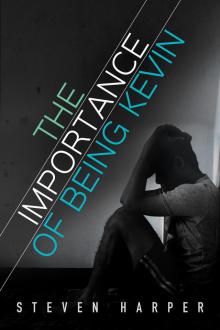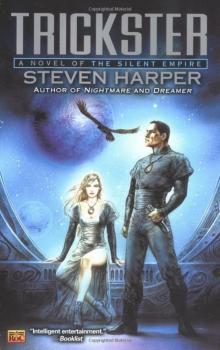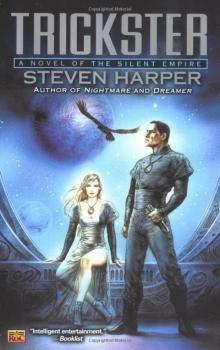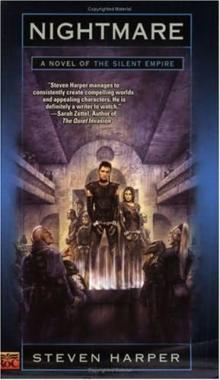- Home
- Steven Harper
Dreamer Page 18
Dreamer Read online
Page 18
But first she needed some questions answered.
Vidya rummaged through the carryall and removed a wide scarf that she expertly twisted into a loose hood around her head. It was a minimal disguise, but she doubted the guard would be looking for her that hard. Sejal was clearly gone, so there was no need to scour the streets for him. There was almost certainly a warrant out for Vidya’s arrest. But it was doubtful the guard would conduct house-to-house searches or cordon off streets. As long as she avoided showing her face and paid hard currency for her purchases, she should be all right.
Tucking the energy whip into her pocket, Vidya left the hotel and gratefully inhaled the fresh night air. Salt breezes mixed with the scent of old plankton, and an overwhelming sense of deja vu stole over her. For a moment she was seventeen years younger, her husband and daughter were newly missing, and she was looking for someone who could ensure the baby growing in her womb would not be Silent, would not disappear. She had failed at that, too. But that was then. Eighteen years of forging a new neighborhood and battling Unity bureaucracy had given her skills and contacts she hadn’t possessed before, and she was more adept at dealing with people. First she would find the genegineer who had altered Sejal. Vidya had been too young, too grateful to ask specific questions before. But that, too, was then.
Vidya squared her shoulders and strode off into the night.
A data pad clattered to the kitchen table. The screen glowed serenely, indifferent to the rough treatment, and the black letters of the message continued to march across the clear plastic. Prasad Vajhur steepled brown fingers beneath his chin. He had known this day would come. It had been inevitable. A part of him, however, had put off thinking about it, hoping it wouldn’t happen. Now he wished he had ignored that particular fantasy and thought about what to do when he had had more time to plan.
Prasad left the pad where he had tossed it. He wandered out of the tiny kitchen, through the equally tiny living room, and down the corridor toward the bedrooms. Prasad commanded a two-bedroom apartment with a den—luxurious quarters on a base where space was at a premium, but that had been part of the deal. Prasad had definitely had his fill of cramped living quarters.
He eased open the door to the first bedroom and peeped inside. A figure lay curled up under the blankets, breathing heavily in sleep. Night-black hair spilled over the pillow and hung over the edge of the bed. The walls were lined with aquariums of varying sizes, and a rainbow assortment of fish darted, floated, or lazed about their tanks. The soft burble of water and steady hum of filters filled the room.
The door squeaked slightly under Prasad’s hand. Prasad tensed, then shook his head with a small smile. He could smash a dozen ceramic plates against the wall and Katsu wouldn’t waken, and that was assuming her sleep was normal. When she was in the Dream, Prasad could probably set off a small explosive and she would never notice. Other Silent could be jolted out of the Dream with the proper physical stimulus but not his Katsu. For the hundredth time he wondered if he should speak to her about that. In the last few months, Katsu had been spending more and more time in the Dream. He didn’t know what to make of it, and it worried him.
Prasad closed the door, went back to the living room, and stared out one of the small round windows. At this time of day it showed nothing but blackness. Prasad tapped a button next to the glass and a floodlight instantly illuminated the immediate area outside. Half a dozen colorful fruit-fish froze, their fins splayed out in fear. Then they fled into the dark depths. Prasad stared at the bed of red kelp and peat that framed his window and carpeted the ocean floor as far as the floodlight reached. The base was hidden under a peat-covered pile of rock, meaning windows were few and carefully hidden. The fact that Prasad and Katsu’s apartment had three of them showed his importance to the project.
At times like this Prasad longed for the days before the Annexation, when he and Vidya took long walks together in the balmy night air. Katsu had grown up completely indoors. An arboretum was no substitute for real weather and wind. Prasad also feared Katsu was lonely, though she had never complained. The only people her age on the station were definitely not suitable companionship.
And now the researchers wanted to harvest her eggs.
Prasad leaned against the cool glass. Soft currents rippled the waving kelp. At times like this he missed Vidya so much it was a physical pain. The worst was not knowing what had happened to her. Was she even alive?
Prasad shut the floodlight off and turned away from the window. He felt restless. Although it was full night, he left the apartment and wandered up the empty corridor.
All the corridors were painted in bright, cheery colors. Murals and holograms in strategic places gave the illusion of space, and both were changed erratically to ease some of the day-to-day monotony. The base itself was a nest of domes and corridors that snaked in all directions. The layout followed no definite pattern, which had initially confused Prasad, but also served to keep monotony at arm’s length. And after seventeen years and a fair amount of silver hairs, Prasad knew every step. His footsteps were hushed by carpet, and the only sound was the faint creaking of ceramic bulkheads as they expanded and contracted under fluctuations in water temperature and density. Prasad ambled aimlessly, not really paying attention to where he was going.
A few minutes’ walk up several corridors and down two staircases brought Prasad to a door labeled Project Lab: Authorized Personnel Only. Prasad hesitated. He had more or less intended to visit the arboretum. His feet, however, had lead him here. Hesitantly, he touched his thumb to the plate mounted next to the door.
“Authorization accepted,” said the computer. “Good evening, Mr. Vajhur.”
Prasad stepped inside. Unlike the base itself, the lab was laid out more sensibly—a small grid of offices at the front, larger grid of locker rooms and labs behind them, and the Nursery behind that. Prasad passed his office and the laboratory area. Several of the lab doors were actually airlocks that bore such labels as “Bio-Hazard,” “Anti-Viral Protocols in Effect,” and “Clean-Suits Required for Entry.”
Prasad continued back to the Nursery. The door was triple-locked and fully a meter thick. He stared at it for a moment, then pressed his thumb to the plate and held it there. He heard the customary tiny hiss.
“Thumbprint and DNA verified,” said the computer. “Welcome, Mr. Vajhur.”
With a soft hum, the locks disengaged and the door swung open. Beyond lay a single long corridor. Prasad stepped inside and the door swung shut again.
The word “nursery” always conjured up wooden cradles, colorful books, and smiling rocking horses in Prasad’s mind. The Nursery, however, thoroughly failed to live up to this image. A main corridor, gray and uncarpeted, branched into several rooms. Prasad glanced into the first. A clear plastic barrier broken only by another heavy door divided the room in two. Four bassinets lined the wall on the other side of the barrier along with a changing table stocked with diapers and other infant supplies. No decorations or pictures graced the stark gray walls. No toys took up space beneath the beds. Instead, a cryo-unit lay below each, ready to receive the child in case of an emergency such as a bulkhead breach.
A collared slave woman sat in a rocking chair with a white bundle in her lap and a bottle in her hand. Prasad nodded to her, and she nodded back. He gestured at the bundle. The slave, who was in her late forties and dressed in a bright orange coverall, gently disengaged the bottle and held up the baby.
It looked perfectly normal for a newborn, though Prasad knew better. Somewhere in the lab’s network computer lay more information on that baby and its nursery-mates than on any other humans in history—DNA, RNA sequencing patterns, mitochondrial structure, brain development, source of DNA. Prasad would never, ever look up that information. He didn’t need it to perform his job, and he didn’t want to know which of the children had sprung from him.
The baby opened its mouth in protest at the interrupted feeding. The barrier woud have kept Prasad from hearing any
thing if there had been anything to hear. These babies never made a sound when they cried. The slave brought the infant back to her lap and plied the little bottle. Prasad moved on.
Further down the corridor was another room-and-barrier combination, though this one had five hospital beds in it with the side-rails raised. Toddler-sized bundles made lumps under the sheets, and Prasad had to look closely to see the motion of their breathing. Another female slave dozed in another rocking chair. A large medical supply cupboard lined the back wall, and various pieces of medical equipment lay waiting in the corners.
Prasad continued down the cool corridor, footsteps echoing slightly. At this hour no one bustled about. Dr. Say and Dr. Kri were almost certainly in bed, probably together. They pretended that there was nothing between them, of course, but everyone knew. The only ones up and on duty were the Nursery slaves. Prasad had initially been startled at the presence of slaves. Dr. Say, however, had explained that they could tell only as few people as possible about the lab’s location. Free people such as Prasad often had families and they wanted much higher payment to stay on an underwater base for months at a time. Slaves, however, cost the same whether they worked above the water or under it, and they didn’t have to be given time away from base. Shock collars ensured they didn’t revolt, and even if they did, there was no place for them to go unless they could hotwire a submarine.
Prasad’s feet carried him past four more rooms containing barrier, beds, and nurse, then halted at the last room of the Nursery corridor. With a grimace, Prasad realized this was where he had been intending to come all along. This room was the largest yet, with eighteen occupied beds. Five slaves, burly and muscular, stood careful guard. The black-haired figures on the beds were strapped in. Atrophied muscles and tendons shortened from disuse made their limbs thin and withered-looking, with claw-like hands that curled under their chins. The fingers twitched like epileptic insects. Prasad stared at them, expressionless, and even as he watched, one of the children opened its eyes. Its head and shoulders came forward as far as the straps would allow, and its mouth twisted open. The neck spasmed, jerking the head about, and a dark tongue quivered between stretched lips. Saliva dribbled down its chin. The barrier was sound-proofed, though Prasad knew that despite the fact that the child looked like it was screaming, it was absolutely silent.
Silent. Prasad stared, ignoring the sidelong glances of the guards. The children were silent and Silent. They—Prasad, Dr. Say, and Dr. Kri—had made them that way. Everyone knew that a Silent fetus had to come to term in a living mother’s womb. It didn’t matter what species the being might be, and it didn’t matter what technology anyone tried as a substitute for a living mother’s voice or heartbeat. Silent fetuses grown in artificial wombs invariably withered and died. Most people assumed that the Silent were, on some level, aware of the minds around them, and the presence of the mother’s mind was crucial.
Until the lab came along. When Prasad first met them, Dr. Say and Dr. Kri had barely begun their research, but they had already made several advances. It was simply a matter of brain chemistry. A developing fetus did not actually have to have its mother’s mind nearby—it only needed to think its mother was nearby.
“All sensation and memory,” Dr. Kri had said in his rich, mellow voice, “is nothing but a series of chemical patterns stored in the brain. All we have to do is figure out which chemical pattern the brain of a live-womb fetus creates when it senses its mother nearby, create that chemical sequence ourselves, and transplant it into the brain of a machine-womb fetus.”
It hadn’t been that simple, of course. Genetic codes—and therefore chemical patterns—varied from fetus to fetus, which meant creating a series of genetically identical embryos. There was also the fact that some gene combinations seemed to thrive better than others. Learning these combinations had taken several years and many failed fetuses. There was also the problem of chemical delivery. They experimented with direct site delivery using microscopic chemical packs slipped into hijacked white blood cells, but in the end, it had been easiest to produce a retrovirus that would bond with—and change—the neural DNA itself, forcing the cells to create their own memory codes.
Prasad had spent his days cutting and splicing genes, many of them his own. Katsu, meanwhile, spent her time in a small nursery area set up within Prasad’s lab. A slave woman looked after her needs, but Prasad had wanted his daughter nearby.
Several fetuses were already gestating by the time Prasad arrived, and it wasn’t long before the babies were born. Very early, however, it became clear that something was wrong. The subjects didn’t respond to outside stimuli. They rarely moved, and they never, ever cried.
After some study, Dr. Kri came to the conclusion that their brains hadn’t developed quite properly. The subjects were barely as intelligent as a fish or a bird. They were certainly not sentient. He had advocated destroying them and starting over. But Prasad had argued vehemently against it. He knew it was because he looked at the infants, perfectly formed but so very quiet, and in them he saw Katsu, but he argued on scientific grounds. Why destroy them when there was more to learn? Dr. Say had agreed and persuaded Dr. Kri.
Other batches of subjects were removed from the machine wombs, but none of them seemed to be intelligent or self-aware. They spent most of their time with their eyes closed and responded only to intense stimuli, especially pain. On the rare occasions when their eyes opened, they were blank and staring. The experiments continued.
Katsu, meanwhile, grew into a toddler and then a child. To Prasad’s pride, she seemed to be extremely intelligent, though she was also very quiet. She seemed possessed of an odd patience, perfectly happy to while away the hours completely by herself. Oddly, she rarely asked questions about the world outside the research base. Katsu seemed to accept the fact that trips to the surface were difficult and rare.
The moment she was old enough, Prasad ensured she could access the computer networks through a disguised link that the Unity would not notice, and she seized on it with an almost startling hunger. Not a social child to begin with, Katsu became even more withdrawn with the addition of network access to her life, and Prasad had to limit the amount of time she spent there. He also kept an eye on what she did with her computer time, and discovered she had a passion for marine biology. By age eight, she was an authority on Rustic ocean life, or so she appeared to Prasad, who knew next to nothing about the subject. He arranged trips for her on the base’s submersile, a small, tank-like vehicle, so she could collect samples of fish and plant life.
She was also fascinated by the experimental subjects. Although they did little but lie still in their beds on the other side of the plastic barrier, Katsu would watch them for long periods with her unreadable dark eyes. At first Prasad and the others had tried to shoo her back to her play area, but Katsu always drifted back. Eventually Prasad gave up trying. It was either let her look or lock her out of the lab, and he just couldn’t bring himself to leave her completely in someone else’s care.
Prasad did worry about Katsu’s social development. The base had little over a dozen other people in it—Drs. Kri and Say, Prasad, a research virologist named Max Garinn, and eleven slaves who cooked, cleaned, and took care of the research subjects. And Dr. Say avoided Katsu. Prasad had never seen her near his daughter. In any case, none of the people were even close to Katsu’s age, and there was no way to arrange playmates. But Katsu didn’t seem to mind. She spent time with her computer, her fish, and her father. Except for the test subjects, the other people on the base barely seemed to exist for her.
Just before Katsu’s ninth birthday, Prasad and other scientists noticed a change in the lab subjects, the ones from the first batch that Dr. Say had wanted to destroy. At times, they expressed agitation, twitching movement that bordered at convulsion. One day when Prasad was observing, one of them sat up and screamed. Or at least, that was what appeared to happen. The subject opened its mouth wide and had a look of fear on its face, but not a single
sound emerged from its throat.
Prasad and the other researchers didn’t know what to make of it. Max Garinn, a tidy, blond man with a long mustache he liked to twirl, was especially fascinated. He offered several theories, none of which sounded plausible. Then Katsu, at her customary place near the barrier, spoke up.
“They’re in the Dream,” she said in her soft voice.
And no matter how much Max Garinn and Prasad urged her, she refused to say more.
Dr. Kri immediately reset the medical sensors to read neural activity among the subjects, something she hadn’t done before because human Silent never showed direct awareness of the Dream without training. She found increased activity in each subject’s right hemisphere, consistent with normal humans in REM sleep and with Silent humans in the Dream. The pons of each subject was also sending a multitude of signals to the thalamus and cerebral cortex, again indicating dream—or Dream—activity.
Excitement reigned in the lab for weeks as the phenomenon was studied. Obviously the early batch of subjects had met with some success—they were able to reach the Dream, and without training. Prasad tried several times to entice Katsu into telling him how she had known, but she continually refused to say.
The same thing happened when the next set of subjects reached their eleventh year, and the next set, and the next. At this point thirty-five subjects were reaching the Dream on a steady basis.
So was Katsu. At age thirteen, two years after the first subjects entered the Dream, she had lain down on her bed and, without help from any drugs Prasad knew about, gone into the Dream herself. She had reported the fact to Prasad at dinner that night in the same tone of voice that she might have used to report the acquisition of a new fish. Astounded, Prasad pressed for details, but Katsu avoided giving them. All she would say was, “They taught me.”

 The Importance of Being Kevin
The Importance of Being Kevin un/FAIR
un/FAIR The Havoc Machine
The Havoc Machine Iron Axe
Iron Axe The Dragon Men
The Dragon Men The Doomsday Vault ce-1
The Doomsday Vault ce-1 The Doomsday Vault
The Doomsday Vault The Dragon Men ce-3
The Dragon Men ce-3 The Impossible Cube
The Impossible Cube Blood Storm: The Books of Blood and Iron
Blood Storm: The Books of Blood and Iron Trickster se-3
Trickster se-3 Offspring
Offspring Bone War
Bone War Trickster
Trickster Unity
Unity Dreamer
Dreamer The Havoc Machine ce-4
The Havoc Machine ce-4 Dreamer se-2
Dreamer se-2 Nightmare se-2
Nightmare se-2